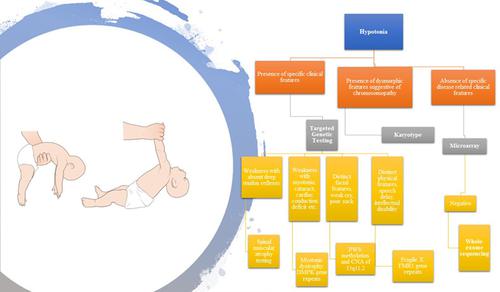当前位置:
X-MOL 学术
›
Clin. Genet.
›
论文详情
Our official English website, www.x-mol.net, welcomes your feedback! (Note: you will need to create a separate account there.)
Diagnostic yield of genetic testing in 324 infants with hypotonia
Clinical Genetics ( IF 3.5 ) Pub Date : 2021-09-03 , DOI: 10.1111/cge.14057 Sonal Sharma 1, 2 , Elena Repnikova 3, 4 , Janelle R Noel-MacDonnell 4, 5 , Jean-Baptiste LePichon 1, 4
Clinical Genetics ( IF 3.5 ) Pub Date : 2021-09-03 , DOI: 10.1111/cge.14057 Sonal Sharma 1, 2 , Elena Repnikova 3, 4 , Janelle R Noel-MacDonnell 4, 5 , Jean-Baptiste LePichon 1, 4
Affiliation

|
This retrospective cohort study was designed to determine the yield of genetic tests in hypotonic infants and develop a diagnostic algorithm. Out of 496 patients identified by International Classification of Diseases (ICD) 9/10 coding, 324 patients met the inclusion criteria. Diagnostic yields were 32% for karyotype, 19% for microarray, 30% for targeted genetic tests, 38% for gene panels, and 31% for exome sequencing. In addition, we considered the diagnostic contribution of ancillary tests, including neuroimaging, metabolic tests, and so forth. The combination of microarray and exome sequencing gave the highest diagnostic yield. None of the other tests added significant value in arriving at a diagnosis. Based on these results we propose that the vast majority of infants with congenital hypotonia should start with a microarray and proceed with exome sequencing, with the notable exception of infants with clearly syndromic features in whom karyotyping or targeted testing may be more appropriate.
中文翻译:

324 例肌张力减退婴儿基因检测的诊断率
这项回顾性队列研究旨在确定低渗婴儿基因检测的产量并开发诊断算法。在国际疾病分类 (ICD) 9/10 编码确定的 496 名患者中,324 名患者符合纳入标准。核型诊断率为 32%,微阵列诊断率为 19%,靶向基因检测为 30%,基因组为 38%,外显子组测序为 31%。此外,我们还考虑了辅助测试的诊断贡献,包括神经影像学、代谢测试等。微阵列和外显子组测序的结合给出了最高的诊断率。其他测试都没有增加诊断的重要价值。
更新日期:2021-11-03
中文翻译:

324 例肌张力减退婴儿基因检测的诊断率
这项回顾性队列研究旨在确定低渗婴儿基因检测的产量并开发诊断算法。在国际疾病分类 (ICD) 9/10 编码确定的 496 名患者中,324 名患者符合纳入标准。核型诊断率为 32%,微阵列诊断率为 19%,靶向基因检测为 30%,基因组为 38%,外显子组测序为 31%。此外,我们还考虑了辅助测试的诊断贡献,包括神经影像学、代谢测试等。微阵列和外显子组测序的结合给出了最高的诊断率。其他测试都没有增加诊断的重要价值。


























 京公网安备 11010802027423号
京公网安备 11010802027423号